A | B | C | D | E | F | G | H | I | J | K | L | M | N | O | P | Q | R | S | T | U | V | W | X | Y | Z |
A
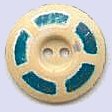 | ALUMINUM STENCIL | A term used for an almost flat aluminum button having several coats of paint, enamel, or lacquer, showing patterns similar to those found on China Stencils. |
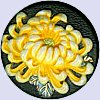 | ARITA | A type of Japanese porcelain, often with colorful glazes. The finish generally has a dark color satin gloss rather than a shiny glaze. |
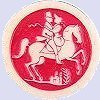 | ARTID | Usually white and one other color, such as black or red. Backmarked with “Artid” and “Made in England” in raised letters. Most are small and have a color border. |
 | AURORA | Buttons with a high degree of iridescent luster show two or more colors when moved or tilted from side to side. |
 | AUSTRIAN TINIES | A 2-piece metal button, never more than 1/2 inch in diameter, with a metal loop shank and, usually, a Japanned back which is frequently cup-shaped. The metal trim is usually folded over the back. The center designs may be pearl, ivoroid, velvet, etc. These buttons were made between approximately 1885 and 1914. |
B
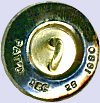 | BACK MARKS | |
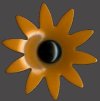 | BAKELITE | An early plastic with both cast phenolic and molded resin, made from the 1920s to the 1950s. Bakelite buttons may be formed or cut and can have escutcheons or inlays. |
 | BASSE-TAILLE | Transparent enamel is applied over a metal base that has been chased, engraved, or turned, so the design in the metal is visible. |
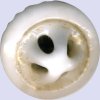 | BIRD CAGE | |
| BIRD’S EGG | Glass buttons that have a speckled overlay. | |
| BLACK GLASS | Glass buttons that appear black to the naked eye when placed upside down on white paper. Includes MOONGLOWs, OVERLAYs, TILEs, and LUSTERs. | |
 | BONE | |
| BUBBLE TOP | A solid sheet of celluloid is drawn over the button frame, with a discernible air space under the sheet. The button may be made entirely of celluloid or may have a metal, paper, or other material back. | |
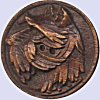 | BURWOOD | Made of molded processed wood pulp without back marks. |
C
| CAEN | Named after a city in northern France famous for horn buttons. If the button has the Caen backmark it is definitely horn. Counts as a French backmark. | |
 | CALICO | A china button decorated with a repeating design, typically of a floral or geometric nature, over the entire surface of the button. |
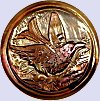 | CAMEO | A raised design in high relief. See also EMBOSSED. |
| CANDY STRIP | Glass buttons with clearly defined stripes of different colored glass run through the body of the button, front to back. | |
 | CASEIN | Early plastic made from milk was produced around the turn of the century. |
 | CATALIN | A brand name for BAKELITE and was produced in the 1950s. |
 | CATGUT | Made by putting a design of metal over a piece of wood. Catgut was wrapped around the wood, and a seamstress would sew the buttons to the jacket by sewing under the crossed piece of catgut. Made in the 18th Century, usually military. |
 | CELLULOID | Celluloid was the first important synthetic plastic and was widely used as a substitute for more expensive substances, such as ivory, amber, horn, and tortoiseshell. Includes IVOROID, ONE-PIECE THIRTIES, and SHEETS |
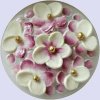 | CERAMIC | Ceramic is a general descriptive term that includes a wide range of natural clay materials. Includes EARTHENWARE, PORCELAIN, and STONEWARE. |
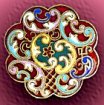 | CHAMPLEVÉ | Enamel buttons where the metal base is grooved or hollowed out, with a die or stamp, to accept the enamel. The surface designs combine metal with enamel. |
| CLEAR COLORLESS GLASS | The body is clear (transparent) and colorless. The button may have a metal back, overlay, decorative finish, and/or embellishment. | |
 | CLOISONNÉ | Enamel buttons where thin metal bands or wires of uniform thickness are placed onto the metal surface to create separate compartments (cloisons), which are filled with enamel, fired, and polished. |
 | COLONIAL PEARLS | Shell buttons from the American colonial period, are characterized by thick mother of pearl, sometimes highly designed, and with a very heavy pin shank in the center. |
| COLORED GLASS | Buttons consist of one or more chromatic colors. The color is determined by the color of the shank (self-shanks) or the glass to which the shank is attached (cemented or metal shanks). See also GOLDSTONE, TRANSPARENT GLASS, and WHITE GLASS. Includes BLOWN, CORONETS, CRACKLE, DESIGN IN GLASS, FLASHED, FOIL EMBEDDED, FUSED, IMPRESSION INLAY, INTERMIXED, CANDY STRIPE, LAMPWORK, MOONGLOW, ENCRUSTED FINISH, SALT FINISH, SHEATH FINISH, PAPERWEIGHT, and SATIN FINISH. | |
 | CORALENE | Tiny glass beads are applied to the surface, primarily glass, but also ceramics, plastics, etc. This technique has been used since the 1880s. |
| CORONETS | Buttons are made from a base and top, each molded separately; usually of different colors. | |
| CRACKLE | Buttons are made from glass which is deliberately cooled quickly to create an internal design of cracks or fractures. | |
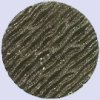 | CRAPE STONE | The design has an imitation crape fabric appearance, in an all-over design of lines or ridges, usually wavy. The designs are cut, not molded, and have very fine hair-like crosslines decorating the high ridges, further identifying this material. Resembling black glass, crape-stones are actually onyx. Used in the 1800s to make mourning buttons. |
 | CRICKET CAGE | |
 | CUT STEELS | Also known as RIVETED STEELS |
D
| DAGUERREOTYPE | One of the earliest (1839) types of photographs in which the image is exposed directly onto a mirror-polished surface of silver bearing a coating of silver halide particles deposited by iodine vapor. The daguerreotype is a direct positive image-making process with no “negative” original. They were made until 1851 when other methods were used. | |
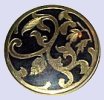 | DAMASCENE | The inlay of different metals onto one another produces intricate patterns similar to niello. Typically, gold or silver is inlaid on steel, lacquered, baked and polished with charcoal, and finished with engraving. These buttons have been made the same way in the same town in Japan for over 1000 years. |
 | DECCAN | |
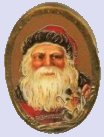 | DECOUPAGE | Art is produced by decorating a surface with cutouts and then coating it with several layers of varnish or lacquer. |
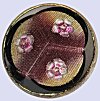 | DESIGN IN GLASS (DIGS) | A smooth, ground, or tumbled button with a subtle design emanating from its surface. A slight impression of the design may be felt on the surface due to irregularities in tumbling or grinding. The design cannot be seen from the back of the button. |
| DESIGN UNDER GLASS (DUG) | ||
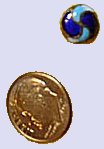 | DIMINUTIVE | From the tiniest button up to 3/8 inch. |
 | DRUM | Drum buttons are so called because the straight, high sides between the front and back give the button the overall appearance of a drum. Many are pad backs, though some have loop shanks. |
E
 | EARTHENWARE | Porous clay is fired at relatively low temperatures. Earthenware buttons may be glazed and/or unglazed, and the clay may be white, cream, buff, yellow, or brown to dark red (terra-cotta). See SATSUMA, RUSKIN, BARUM, NORWALK, DELFT, and ZIA. |
| EGLOMISE | A type of reverse painting on glass. Gold was laid on the reverse side of the glass piece, and the design was cut out of the gold. Then the whole back of the glass piece was covered with black. | |
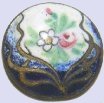 | ÉMAUX PEINTS | Enamel is applied to the surface of the button to form a base upon which the design is painted and then fired. |
 | EMBEDDED SHANK | |
| EMBOSSED | A raised design in low relief. See also CAMEO. | |
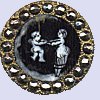 | EN GRISAILLE | Multiple layers of white enamel are applied to a base of dark enamel. As coats are added and fired, gray tones have created that act as shadows and give a three-dimensional effect. |
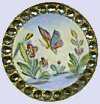 | ENAMEL | A decorative finish of glass fired onto metal. Includes BASSE-TAILLE, CHAMPLEVÉ, CLOISONNÉ, ÉMAUX PEINTS, EN GRISAILLE, ENAMEL ENCRUSTATIONS, FOIL ENCLOSURES, GIN BARI, LIMOGE, PAILLONS, PIERRERIES, and PLIQUE-á-JOUR. |
| ENCRUSTED FINISH | Glass buttons have a granular or globular surface coating applied and fired after the button is made. | |
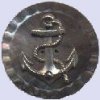 | ESCUTCHEON | A term used to describe a metal ornament applied to the button and attached, usually, with one or two pins going through the button and bent down on the back. These metal designs, in shapes, as varied as stars, heads, animals, or even complete scenes were attached to virtually all button materials including wood, shell, all plastics, bone, vegetable ivory, glass, metal, or composition. |
F
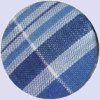 | FABRICS | Any material of animal, vegetable, or mineral origin that is woven or felted. |
| FACE CENTER | A metal back, faced or centered with a flat sheet of celluloid, and rimmed by a plain or fancy metal border. | |
| FIMO | See Polymer Clay. | |
| FLATS | Buttons have a perforated celluloid top backed by a flat piece of fabric, paper, celluloid, metal, or foil. See PERFORATE | |
| FLASHED | Buttons made from transparent colored or clear glass canes with additional color(s) either on one side of the cane’s surface or all around it so the color may appear on the back, front, or both, or on the inside of the button. | |
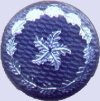 | FOIL EMBEDDED | Any glass button with foil embedded under the surface. See also POPPERs. |
| FOIL ENCLOSURES | Pieces of metallic foil are laid in place and covered by transparent enamel. | |
 | FOPS | Buttons with males or females depicting the excesses of French aristocratic costumes around the end of the 18’h Century. |
| FOUR-WAY METAL SHANK | A hollow metal cube with four openings, embedded into the button. | |
| FUSED | Buttons made of two or more layers of prefabricated glass cut out and put together in various artistic arrangements with heat. Fused Glass buttons usually have glued-on shanks. |
G
| GALALITH | Another name for CASEIN | |
 | GALENA | |
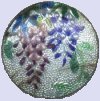 | GIN-BARI | A style of Japanese cloisonnÉ that uses lightly tinted clear enamel over a very thin sheet of detailed silver. |
 | GINGHAM | china buttons decorated with a surface design imitating boldly patterned fabric. |
 | GOLDEN AGE | A collector’s term for gilt or plated pictorial, non-pictorial, and plain-faced buttons of American manufacture during the period from 1820 to 1850. |
| GOLDSTONE | Glass buttons consist of copper-colored metallic particles embedded in the glass. | |
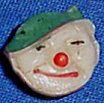 | GOOFIES | Term coined by Dorothy Foster Brown for realistic. “The more frivolous types of modern buttons, the word “Goofy” popped into my head and it seemed to fill the bill. The buttons are gay, colorful, irresponsible, and amusing, the antithesis of all things serious or dull.” |
H
 | HABITAT | Buttons containing insects, flowers, seaweed, shells, etc., are preserved to create scenes or designs. |
 | HORN | Horn buttons were generally made from a soupy mixture (slurry) of hooves, horns, and water. The mixture was poured into molds, then allowed to harden. Sometimes a dye was added, with black and red being the most common colors. They may have pick marks or bookmarks. These are “molded” or “pressed horns” though there were buttons made from carved horns or antlers, and these are referred to as “carved horns.” |
I
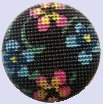 | IMITATION FABRIC | Molded designs imitating fabric, needlework, lace, cording, beading, etc. |
| IMPRESSION INLAY | Glass buttons with metal embellishments (such as rings, bracelets, small balls, realistic shapes, etc.) are pressed into the glass while in a softened state. | |
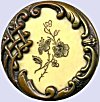 | INCISED | Thin shallow line designs which look as if they were drawn with a pointed tool. |
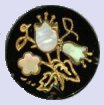 | INLAY | Metal embellishment is pressed into the button while in a softened state. Inlay materials include pearl, pearl chips, yellow and white metal shapes or cutouts, ivory, tinsel, and sharkskin pellets. |
| INTAGLIO | Buttons where the entire design is in clear relief below the surface. This is the reverse of CAMEO. | |
| INTERMIXED | Buttons are made of opaque, translucent, or transparent multi-colored glass, with more than one color visible on the button back. | |
 | IVOROID | Sheet celluloid is pressed, tinted, and rubbed down to imitate carved ivory. They were then given a wash of black to bring out the details. Some have cut-out designs attached in places to a celluloid ring hidden by a metal rim. Nearly all ivoroids have metal rims and backs. |
J
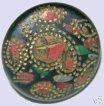 | JAPANNED | A heavy black paint, almost like enamel, is usually applied to the back, though sometimes used as a background for buttons. |
 | JASPERWARE |
K
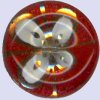 | KALEIDOSCOPE | Buttons made from a molded transparent glass dome with a flat back covering an applied pattern of two or more colors, affixed to a metal plate almost as large as the base of the dome. |
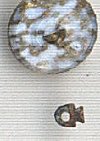 | KEY SHANKS | |
 | KUTANI |
L
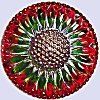 | LACY | Delicate molded surface designs, often with fine stippling. |
| LAMPWORK | Buttons made from glass worked over an open flame, usually with a torch. These buttons are often realistic with self-shanks. | |
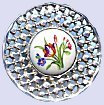 | LIMOGES | See ENAMEL |
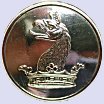 | LIVERY | Typically depicting heraldic designs of the family, livery buttons were worn on uniforms (livery) of servants and only occasionally by the owner. Major types include achievements, and crests; there are also badges, initials, and monograms. |
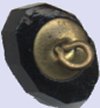 | LOOP SHANK | |
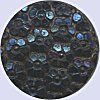 | LUSTERs | Metallic lusters or combinations of lusters, partially or fully covering the surface of a button. |
M
 | MEASLES | The name comes from the ubiquitous red dots on ill children. Competitors who enter a tray with buttons not appropriate to the entry get a little dot on the plastic cover sheet. One dot, or measle, is enough to disqualify an entire tray from the competition. |
| MEASURE | A tool used by button collectors to determine sizes for competition. There are two types, the Linley measure, and the NBS flat measure. | |
 | MODERN | |
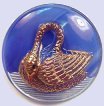 | MOONGLOW | Colors other than black (often striped) appear in the glass between the base and the clear glass top layer. The back and/or self-shank appears black when placed against white paper. |
N
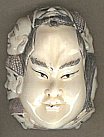 | NETSUKE |
O
| ONE-PIECE THIRTIES | Wafers with embossed or pressed designs that are often pictorial, usually depicting sports, animals, transportation, etc., with a field surrounding the design which is either textured or smooth. One-piece thirties may be a two-hole sew-through or have an applied celluloid shank. | |
 | OVERLAYs | Clear and/or colored glass fused to the surface of a black glass body. |
| OUTLINE | See INCISED. |
P
 | PAD BACK | A button back, where a pad of canvas-like cloth protrudes through a center hole in a metal back. |
| PAILLONS | Enamel buttons with small, precisely cut and shaped, foil enclosures. The enclosures often take the shape of realism. | |
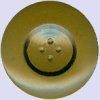 | PAPER BACK | A clear glass button with a piece of paper glued onto the back, without a metal back for protection. |
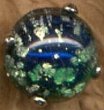 | PAPERWEIGHT | Buttons are made by fusing together a set-up and a transparent cap, or crown. The set-up is independently made and decorative in nature. The base determines the color of the button. |
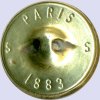 | PARIS BACK | |
 | PASTE | Paste (or “strass”) is a heavily leaded glass approximating a true gem in luster and brilliance. A German named Strass perfected a formula for a paste that was so admired that his name became the trade name for all fine paste. |
| PIERRERIES | ||
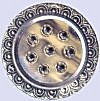 | PERFORATE | A perforated celluloid top that fits over protruding design piece(s) of metal, glass, celluloid, etc. (Stick-ups); or a perforated celluloid top backed by a flat piece of fabric, paper, celluloid, metal, or foil (Flats). |
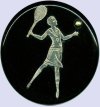 | PHENOLIC PLASTIC | A thermoset synthetic polymer. Buttons look and feel hard and dense. The hot needle test gives formaldehyde or Lysol smell. The most common brand names are Bakelite and Catalin. |
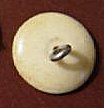 | PINSHANK | |
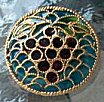 | PLIQUE-á-JOUR | A design made of soldered wires or openwork metal, filled with transparent, translucent, or opaque enamel that is not backed by metal, resembling stained glass. |
 | POLYMER CLAY | A workable colorful medium that comes in many colors for sculpting, molding, and cane making. It stays soft almost indefinitely until baked to permanent hardness in a home oven making it very popular with artisans and crafters. Often used for buttons, both in mass production and by studio button makers. The most common brand names include Fimo and Sculpey. |
 | POPPER | |
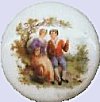 | PORCELAIN | A hard, white, translucent ceramic made by firing a pure clay and then glazing it with variously colored fusible materials; china. Includes all white, nonporous, translucent hard paste, and opaque soft paste ceramics. See ARITA, KUTANI, and MEISSEN. |
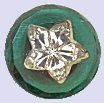 | PRECISION INLAY | Feeling almost seamless, the inserted material either fits precisely or is ground down level with the button surface. Both base and insertion material(s) are in a solid state when joined. The base material is either molded or cut to accommodate the inlaid piece(s). |
Q
| N/A |
R
 | REALISTICS | A button in the actual shape of an item. It can be just the outline, or the surface can make it a real 3-dimensional realistic. A realistic can be made of any material, can be of any age, and can be a studio button or mass-produced. |
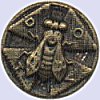 | REBUS | Rebus buttons satisfied the rage for riddles by presenting words, numbers, and pictures that sounded like or represented other words and phrases. |
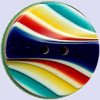 | RHODOIDS | |
| RIVITED STEEL | See CUT STEELS | |
| ROSARIAN | Glass buttons were made with a hole through the center where the brass wire shank was inserted. Commonly referred to as PIN SHANKS | |
 | ROSETTE SHANK | A 6-petal-shaped plate supporting a loop shank. |
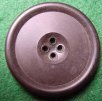 | RUBBER | Buttons made of hard rubber. May or may not have back marks such as the following: N.R.Co. = Novelty Rubber Company I.R.C.Co. = India Rubber Comb Company I.R.C.Co. = India Rubber Comb Company A.R.Co. = American Rubber Company |
S
| SALT FINISH | Glass buttons that have finely crushed glass, called frit, are applied to the surface while still hot and soft. The surface looks and feels rough, like salt. | |
| SATIN FINISH | Buttons are identified by a satiny sheen when turned in the light. | |
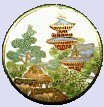 | SATSUMA | Japanese porcelain typically with a soft shiny cream crackled glaze. Gold decoration in the form of outlines, borders, and finely dotted shading and backgrounds set off the designs. Generally, the back shows the typical cream crackled. Matte black and cobalt blue backgrounds are also found. |
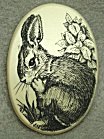 | SCRIMSHAW | Bone or ivory products decorated with engraved designs highlighted with dark agents (such as India Ink or Lampblack) rubbed into the engraved lines. Some scrimshaw is colored with inks or berry stains. |
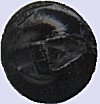 | SELF SHANK | A button back is made of 2 or 3 separate pieces, where the inserted back piece forms the shank portion of the button. |
| SHEATH FINNISH | Glass buttons with a core of one color covered or decorated with different colors (s). The button color is based on the color showing at the tip of the shank. | |
| SHEETS | Buttons are made from a thin sheet of celluloid mounted in metal or drawn-like fabric over a button frame. See also: Bubble Top, Face Center, Perforate, Shield, Tight Top. | |
| SHIELD | A thin sheet of transparent celluloid is used to shield something fragile, such as fabric, lithographs, or habitat material. | |
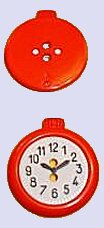 | SNAP-TOGETHERS | Modern buttons are molded in two or more differently colored pieces designed to be put together (snapped). When snapped together, they may be simple realistic, or complex buttons such as a 4-piece button that has a pearlized center, a gold (metalized plastic) ring, a ring of molded pearlized balls, and a black base. |
 | SNAPPETTES (SNAP-ONs) | |
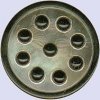 | STICK-UPS | A perforated celluloid top that fits over protruding design piece(s) of metal, glass, celluloid, etc. When there is a metal rim, it is a separate piece; when rimless, the celluloid sheet folds down over the edge to hold parts together. See PERFORATE |
 | STONEWARE | Hard, non-porous clay that is either glazed or unglazed (bisque). See JASPERWARE and WEDGWOOD. |
| SWIRBACK | A cord-like winding off of the button around a metal shank. |
T
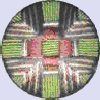 | TEXTILES | See FABRICS |
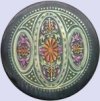 | TIGHT TOP | A solid sheet of celluloid is drawn tightly and smoothly over the button frame. Usually, a metal band clamps the celluloid to the back. |
 | THREAD GROOVE | |
 | TILEs | A tile design is molded into the glass body, filled with either molten glass or glass powder, then fused with heat. The entire surface is smooth and level. |
 | TINGUE | A layer of clear colorless glass with a very thin colored glass (typically red) sheet overlay on top. This piece is cemented to a glass base with a thin sheet of reflective gold foil or leaf between them. The button is faceted to improve reflection. |
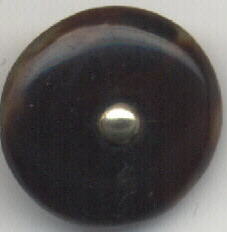 | TORTOISE SHELL | Originally made from the shells of tortoises, imitation tortoiseshell is far more common, and can be either glass or plastic, or sometimes a horn. |
| TRANSPARENT GLASS | Glass buttons that show light through at least one angle or direction. This differs from CLEAR COLORLESS GLASS in that buttons may contain blends of multiple transparent colors. | |
 | TURRET SHANK | |
 | TWINKLES |
U
| N/A |
V
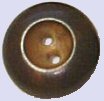 | VEGETABLE IVORY | Made from corozo or taugua palm nut, they are naturally light beige color and take dye well. Often the self-shanks were drilled after dyeing, showing the natural color. Buttons were carved and drilled, dyed, painted, printed, and impressed with designs of all sorts. Metal escutcheons, pearl and glass inserts, and holes filled with glitter decorate vegetable ivory. Pores can be seen. |
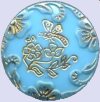 | VICTORIAN | Buttons with opaque, translucent, or transparent glass, with low relief and/or finely incised flowing designs (art nouveau). |
W
 | WATCH CASE | |
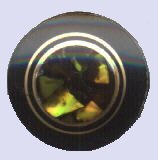 | WATCH CRYSTAL | Buttons made with a fragile glass top, resembling a watch crystal, attached to a wide shank plate with a thick layer of adhesive material. |
 | WHISTLE | A term strictly used by collectors, it refers to all buttons constructed with one hole on the top and two or more holes on the back. This was done to save on the wear and tear of the thread. When the button is sewn on, the thread becomes recessed, therefore protecting it from daily wear. Whistle buttons can be found in a wide variety of materials. |
| WHITE GLASS | Includes Mile, clambroth or camphor, opalescent, ivory, and cream glass. |
X
| N/A |
Y
| N/A |
Z
 | ZIA |











